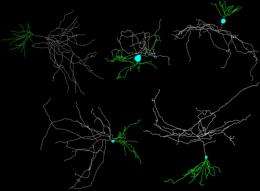Computational intelligence opens up new avenues in Alzheimer's research

Researchers from the Computational Intelligence Group based at the Universidad Politécnica de Madrid's Facultad de Informática have used machine learning and data mining techniques to compare gene expresssion levels in Alzheimer's disease (AD) patients in two key regions of the hippocampus: the dentate gyrus, where the disease appears to have little or no effect, and the entorhinal cortex, where Alzheimer's disease produces major neuronal damage.
The results, published in Computer Methods and Programs in Biomedicine, corroborate previous findings by other studies and set forth new working hypotheses for AD research.
Dentate gyrus and entorhinal cortex
The hippocampal formation is a complex structure situated in the medial temporal lobe of the brain. It plays a key role in memory, attention and spatial navigation. It is composed of six regions: presubiculum, subiculum, parasubiculum, dentate gyrus, hippocampus and entorhinal cortex. A noteworthy part of this formation is the dentate gyrus, one of the few regions of the brain where new neurons continue to be born (neurogenesis) throughout adulthood. It is known that neurogenesis plays a key role in the generation of new memories. Postmortem histopathological studies have provided evidence that the dentate gyrus is the hippocampal region least affected by AD.
The entorhinal cortex is the primary interface between the hippocampus and the neocortex. This region plays a key role in memory formation and consolidation, as well as the retrieval of autobiographical, declarative and spatial memories. Today, we know that the entorhinal cortex is not only one of the first areas to be affected by AD but also where its progression produces most lesions.
Data analysis using an ensemble of Bayesian classifiers
The data mining technique used is part of the computational intelligence discipline. Thanks to the computational power available today, vast amounts of complex data can be analysed holistically to identify new findings or set forth new hypotheses. This study has used ensemble statistical techniques applied to mathematical models to search for relevant genes and gene dependency networks. In both cases, the mathematical paradigm used is called Bayesian classifier.
Results
The results identify relevant genes in different neurological diseases, as well as key metabolic mechanisms that corroborate earlier molecular research in AD. One of these findings is the deregulation of the DEC1 and BTRC genes that help to regulate the molecular clock controlling the body's circadian rhythm.
One of the most common symptoms of AD is sleep disorder, an effect of the loss of the circadian reference. Patients' brains do not correctly identify when they should sleep or be awake. Sleepless periods increase amyloid beta levels, causing the disease to progress.
Another noteworthy result is the deregulation of the S100A10 gene. This gene plays a key role in serotonin receptors, whose activity is linked to neuropsychiatric symptoms in AD patients.
Similarly, it is known to be involved in the pathogenesis and deregulation of depressive disorders. The level of this gene's differential activity between the dentate gyrus and entorhinal cortex corroborates both these associations and recent findings identifying it as a new early biomarker of AD.
More information: Armañanzas, R., Larrañaga, P. & Bielza, C. (2012). Ensemble transcript interaction networks: A case study on Alzheimer's disease. Computer Methods and Programs in Biomedicine, 108(1), 442-450.

















